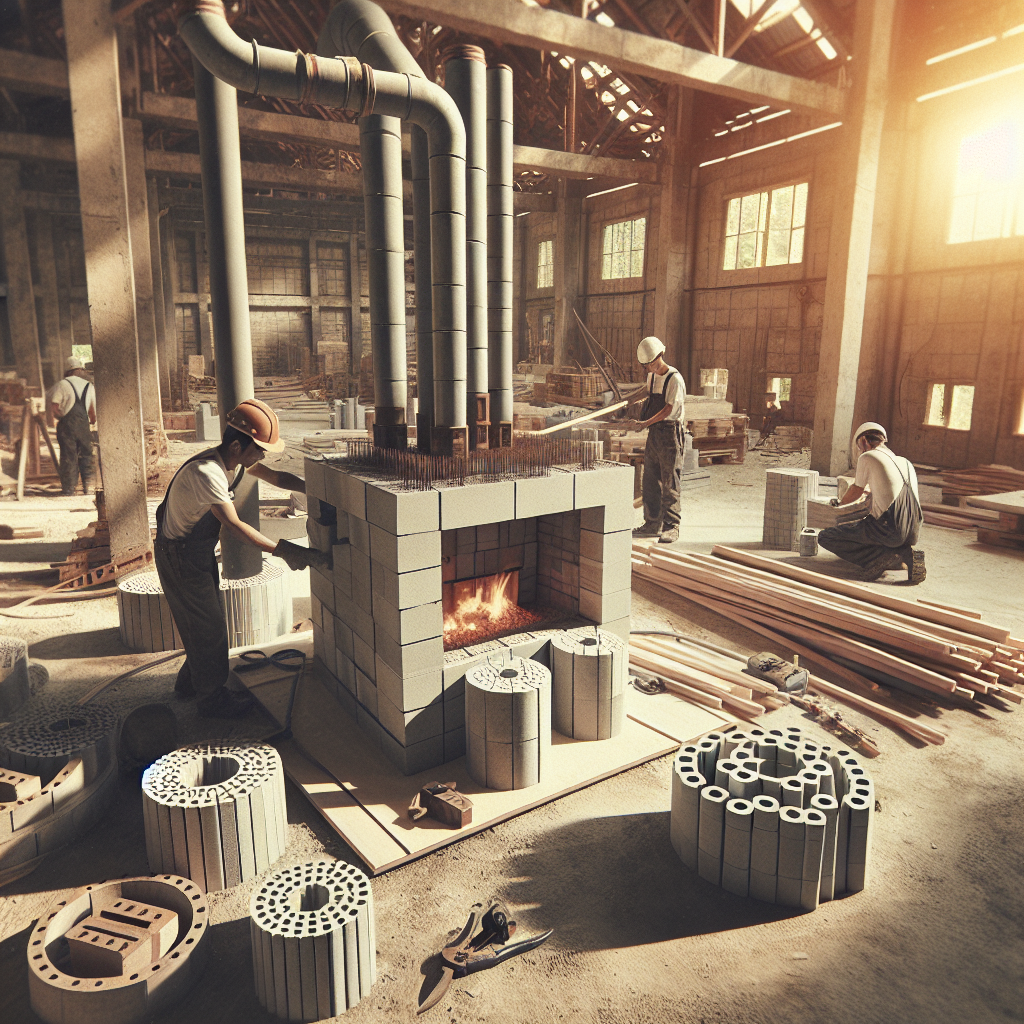Introduction to Masonry Heaters
Ever pondered the benefits of heating your home with a masonry heater? You’re not alone; many homeowners are actively seeking out eco-friendly, efficient heating alternatives. In this guide, we’ll explore what masonry heaters are, their working mechanism, and the factors to consider when incorporating them into your home design. We’ll also compare masonry heaters to other heating solutions and evaluate their advantages, limitations, and environmental impact. Ready to unlock the potential of this age-old heating technology? Let’s get started!
Masonry Heater Efficiency Explained
Understanding Masonry Heaters
A masonry heater is a type of wood-burning stove designed to capture and store heat from a rapidly burning fire. This stored heat is then slowly released into living spaces over time.
Key Features of Masonry Heaters
- Heat Retention: Made of thick masonry materials like brick or stone, these heaters retain a significant amount of heat.
- Efficient Combustion: Burns wood at high temperatures and efficiency, reducing smoke and emissions.
- Long Heat Release: Provides warmth slowly, maintaining comfort without constant refueling.
- Versatile Functions: Offers the possibility of integrating baking ovens or benches.
Measuring Masonry Heater Efficiency
Efficiency in masonry heaters is gauged by their ability to convert wood into usable heat.
| Aspect | Details |
|---|---|
| Combustion Efficiency | High combustion efficiency due to complete combustion at high temperatures. Reduces pollutants. |
| Heat Retention | The efficiency comes from storing heat in the massive masonry structure. |
| Fuel Use | Efficient in wood use as it requires less frequent fires. |
| Heating Duration | Heats a home for 12-24 hours after the fire burns out. |
Comparing Masonry Heaters to Other Heating Methods
Compared to traditional wood stoves or fireplaces, masonry heaters offer higher efficiency and sustainability.
- Wood Stoves: While also efficient, they require more frequent refueling than masonry heaters.
- Fireplaces: Ordinary fireplaces are less efficient as much heat is lost through the chimney.
- Central Heating: Masonry heaters can be used alongside central heating to reduce reliance on fossil fuels.
Environmental Impact
Masonry heaters provide eco-friendly heating by maximizing the use of renewable resources. Their efficient combustion process results in lower emissions, making them a preferable option for sustainable heating. According to Energy.gov, choosing efficient heating solutions can significantly contribute to energy savings and environmental conservation.
The Working Mechanism of Masonry Heaters
The Structure of a Masonry Heater
A masonry heater comprises several main components that contribute to its efficient operation. At its core, a masonry heater includes a firebox where the fire burns, and a network of channels or flues. These channels are often labyrinthine, designed to extract maximum heat from the smoke that threads through them.
The Burning Process
The operation of a masonry heater begins with igniting a fire in the firebox. With a supply of seasoned hardwood, a strong, intense fire is recommended. The temperature can reach up to 2000°F, a heat level encouraging almost complete combustion. This process eliminates most harmful particles that would be present in a low-temperature combustion, thereby reducing emissions and enhancing efficiency.
Heat Absorption and Distribution
The hot gases produced during combustion do not go straight up the chimney. Instead, they wind their way through the network of flues within the heater’s masonry mass. The heat from these gases transfers to the walls of these flues, heating the entire mass of the stove. After this, the cooled gases exit through the chimney. Meanwhile, the masonry heater’s mass has absorbed the bulk of the fire’s heat and gradually radiates this heat into the surrounding space.
Incorporating Masonry Heaters in Home Design
Central Placement
To maximize heat distribution, architects often recommend placing masonry heaters in the center of a home. This central location allows for an even dispersion of the radiated heat throughout the living area.
Integrated Functions and Aesthetics
Taking advantage of their heat retention properties, some masonry heaters integrate additional functional elements such as seating benches or cooking ovens. This feature truly makes them more than just heating elements – they act as domestic appliances and architectural features at the same time.
Benefits of Masonry Heaters
Consistent Comfort
One remarkable advantage of masonry heaters is the continuous, steady comfort they provide. After the initial intense fire, the masonry mass takes over by slowly releasing the stored heat, eliminating the need for constant refueling.
Lower Emissions
Given their high combustion efficiency, masonry heaters work with lower emissions than many conventional heating options. This reduction in smoke and particulates is healthier for both the inhabitants and the environment.
Economic Heating Solution
While the initial cost for a masonry heater can be considerable, their operational costs are low. The efficient burning process reduces the amount of firewood needed, and the prolonged heat release times make these heaters an economical long-term solution.
Contribution to a Greener Future
Respected sources like the Environmental Protection Agency (EPA) champion the use of heating solutions like masonry heaters that contribute to energy conservation and reduce the environmental footprint.
Can a Masonry Heater Heat a Whole House?
The Heating Capacity of Masonry Heaters
Masonry heaters have gained popularity not only for their efficiency but also for their ability to heat entire homes. This capacity largely depends on the size of the masonry heater and the architectural layout of the house. A well-sized masonry heater, when strategically placed in the center of a home, can effectively distribute heat to surrounding rooms. This is because the substantial masonry mass can absorb a lot of heat during a short, hot fire and then radiate it slowly for 12 to 24 hours.
Factors Influencing Heating Effectiveness
Several factors can influence how well a masonry heater can heat a whole house:
- Climate and Home Insulation: In colder climates, excellent home insulation is important for a masonry heater to be effective. High-quality insulation keeps the heat where it belongs – inside your home.
- House Layout and Size: Open floor plans allow heat to move freely, enhancing the heater’s reach. Larger homes may require additional heating sources or larger masonry heaters.
- Wood Quality: Using well-seasoned, high-density hardwoods can maximize the heater’s efficiency and output.
Integration with Other Heating Solutions
For those wondering if a masonry heater is enough, integrating it with other heating systems can often enhance its effectiveness:
- Passive Solar Design: Combining masonry heaters with passive solar heating design can further increase their efficiency. Homes designed with large south-facing windows can absorb solar energy, reducing the demand on the masonry heater.
- Supplementary Heating: In very large homes or extremely cold temperatures, supplementary heating systems – such as underfloor heating or central HVAC systems – can be utilized to ensure even temperatures throughout the house.
Comparative Benefits Over Other Systems
When compared to other heating systems, masonry heaters still hold significant advantages:
- Sustained Warmth: Unlike forced air systems that cycle on and off, the steady radiation of warmth from a masonry heater provides consistent comfort.
- Low Operational Costs: After installation, they have low operational costs due to efficient fuel use and the longevity of each heating cycle.
In conclusion, while masonry heaters alone may not always be sufficient in very large or poorly insulated houses, they can effectively heat many homes, especially when used in combination with other strategies and systems. For further information, consider visiting Home Depot for advice on the proper sizing and installation of masonry heaters.
Disadvantages of Masonry Heaters
Installation Costs
One of the notable disadvantages of masonry heaters is their substantial installation costs. Building a masonry heater is labor-intensive and requires specific materials such as stone or brick, which can add up. Additionally, skilled labor is often necessary to construct these systems properly, further increasing the expense.
Space Requirements
Masonry heaters take up a considerable amount of space within a home. Their size is necessary for holding the masonry mass, which stores and radiates heat. This means smaller homes or houses with limited space may not accommodate such a heating system easily.
Long Warm-Up Time
While masonry heaters are efficient at maintaining heat, they take a longer time to warm up initially compared to other heating methods. If immediate heat is needed, such as in a sudden cold snap, a masonry heater might not deliver prompt warmth.
Limited Cooling Effect
Though highly efficient during cold seasons, masonry heaters contribute little to a cooling system. In climates where cooling is as critical as heating, reliance solely on masonry heaters isn’t prudent. A supplemental air conditioning system is often necessary, potentially raising overall energy costs.
Professional Maintenance
Routine maintenance for masonry heaters can be more demanding compared to other heating systems. Professional inspection and upkeep are advisable to ensure the heater functions optimally, prevent creosote buildup, and address any masonry repairs.
Regional Limitations
The effectiveness of masonry heaters can be limited in geographic regions with milder winters or where the demand for continuous heating is low. In such areas, the heater’s capabilities might be underutilized, which doesn’t justify the initial investment.
Masonry heaters have distinct benefits but come with challenges that necessitate thoughtful consideration. For more on alternative heating methods that might suit different spaces or climates, visit Houzz for expert advice and options.
Conclusion: Understanding Masonry Heaters
Masonry heaters offer a unique heating solution, their construction allowing for an efficient release of heat over long periods and a reduction in harmful emissions. These heaters shine in their ability to efficiently burn wood, offer versatility in function and design, and provide a sustainable heating solution for homes. However, there are also considerations for potential owners, such as substantial initial costs, space requirements, and their suitability to varying climate conditions and building types.
In summary, with their ability to offer consistent comfort, reduced emissions, and efficient use of fuel—all while serving as an aesthetic addition to a home—masonry heaters prove a compelling and eco-friendly alternative to traditional heating systems. Their limitations, however, call for careful consideration to reap the best rewards from these impressive heating behemoths.
Frequently Asked Questions – FAQs
What makes masonry heaters efficient?
Masonry heaters achieve their efficiency primarily through their design, which captures and retains heat from the fire, releasing it slowly over time. They are also valued for their high combustion efficiency, burning wood at high temperatures to reduce smoke and harmful emissions.
Can a masonry heater heat an entire house?
Yes, a well-placed and correctly sized masonry heater has the potential to heat an entire house. However, factors such as the layout and insulation of the home, quality of wood used, and the climate can influence the heater’s effectiveness.
What are the disadvantages of masonry heaters?
Limited cooling ability, high installation costs, space requirements, and more complex maintenance needs are some drawbacks of masonry heaters. However, in a suitable home and climate, the benefits of efficient, sustainable heating can outweigh these disadvantages.






